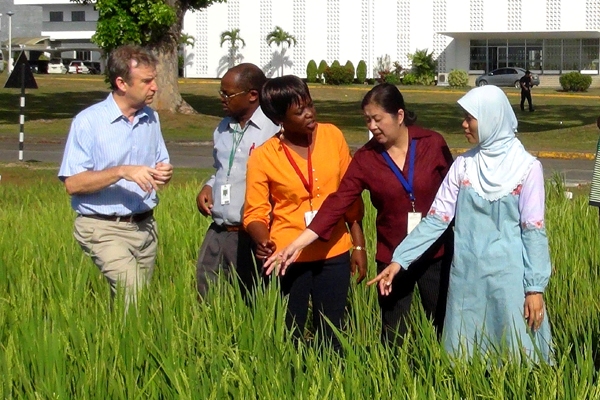
Rice Today has come a long way since its first issue in 2002, when its editorial contents were almost all coming from the International Rice Research Institute (IRRI). The magazine has evolved along with rice science. It now works as part of the new world of rice research under the Global Rice Science Partnership (GRiSP), a global initiative to bring together more than 900 institutions in solving the challenges in rice production.
Partnership, collaboration, and working together became the operational words of GRiSP’s work in its goals of increasing rice productivity and value for the poor, fostering more sustainable rice-based production systems, and improving the efficiency and equity of the rice sector through better and more accessible information, improved agricultural development and research policies, and strengthening delivery mechanisms.
Like GRiSP, the contents of the magazine also point toward this direction for truly, no one is an island in the world of rice science and development. For example, success in the unprecedented sequencing of 3,000 rice genomes of varieties and lines is a product of collaboration among IRRI, BGI in Shenzhen, China, and the Chinese Academy of Agricultural Sciences. See Dawn of the new era in rice improvement to find out how this achievement is changing the way rice breeding is done.
In IRRI’s Long-Term Continuous Cropping Experiment, people working together spans several generations of scientists who have worked to answer some questions that are critical for the future of rice farming. Is intensive farming sustainable? How much rice can a farmer optimally produce on a piece of land in a year? Can farmers produce more with less use of resources such as water, land, and farm inputs and with less impact on the environment? Find the answers to these questions.
In India, we highlight a knowledge dissemination effort that complements the work of the Stress-Tolerant Rice for Africa and South Asia (STRASA) project that is providing farmers with improved management practices Partnerships that work to successfully grow the new climate-smart rice varieties. See More than seeds.
On to Latin America where seven countries are working together with the International Center for Tropical Agriculture (CIAT) to push the rice breeding envelope to improve the lot of rice-growing communities in the region. And, in Ecuador, farmers may find that allying with birds of prey could help them combat apple snails, a serious rice pest (see Flying heroes of Ecuador’s rice fields). From Africa, read about Kazuki Saito—one of the continent’s “most valuable players” in rice research. See how his determination and leadership in conducting field research, in close collaboration with researchers and farmers, are leading to tangible results, even under difficult circumstances.
We also have a story that might rekindle your belief in love and destiny. IRRI’s Krishna Jagadish and Impa Somayanda found one another through science—and love has kept them together ever since in Smitten by science.
We have a double dose of rice facts in this issue. David Dawe, FAO senior economist, explains why rice is cheaper on the world market but more expensive in some local markets and why, in some countries, this is not the case (see The two faces of rice prices). And Sam Mohanty, IRRI’s senior economist, sheds light on why The global rice market is winking at El Niño and Thai problems. In our Grain of Truth column, Tony Fischer, a renowned agricultural scientist from Australia, provides some insights into Yield increase prospects for rice to 2050 and gives some clues on how we could close the gap between the demand for rice in 2050 and the supply.
I hope you enjoy these and our other features in this issue.
Lanie Reyes
Rice Today managing editor







